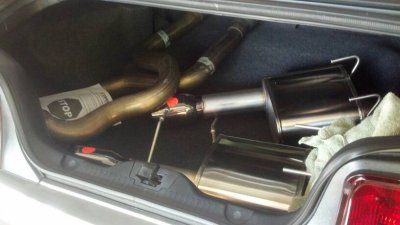So installing a lighter flywheel, driveshaft, or any rotational drivetrain part doesn't actually add horsepower. I think everyone knows that. But on a dyno, it does show up as increased power/torque because there are now less drivetrain losses, if that makes any sense.
30 torques sounds like a LOT, though.
Seems like it should be possible to compute how much of an improvement you'd see, actually.
Driveshafts are generally hollow, so the bulk of their weight is at the periphery. The stock driveshaft weighs 38 pounds. The aluminum driveshaft is about 20 pounds lighter.
But the problem is that the weight isn't the entire part of the story. Take a look at this image, that shows both the stock driveshaft and a 3.5" aluminum driveshaft side by side:

What determines how much rotational resistance is presented by a rotating body is its moment of inertia, otherwise known as its angular mass. The moment of inertia is computed by breaking up the mass into lots of tiny bits, multiplying the mass of each bit by the square of the distance of that bit from the center of rotation, and adding all of those results together.
If we assume the mass of the driveshaft is evenly distributed along its length and about its center axis, then its moment of inertia would be (m*r^2)/2 (see
http://en.wikipedia.org/wiki/List_of_moments_of_inertia, which has formulae for the moments of inertia for various shapes. I'm using the cylindrical shell with open ends as the approximate shape for this exercise).
Now, the stock driveshaft appears to have a diameter about 3/4 that of the aluminum driveshaft (based on measuring the diameters in Photoshop) for half its length, and 5/6 for the other half. Considering the radii are being squared in the formula, that puts the average diameter for the stock driveshaft at about 0.8 that of the aluminum one. The aluminum driveshaft in the above is 3.5", so that would make the stock driveshaft about 2.75" in diameter on average, for the purpose of a moment of inertia calculation.
But what we really want to know here is the ratio of the moments of inertia of the two driveshafts. The ratio of the masses is about 18/38, or about 0.47. The ratio of the square of the radii is 1.62. Multiply those together, and the aluminum driveshaft has a moment of inertia about 0.77 that of the stock driveshaft.
Hence, the accelerative losses for the aluminum driveshaft are about 0.77 those of the stock driveshaft.
But how much is that, really?
To know that, we have to know how much of a rotational rate gain in a given period of time the driveshaft will go through when accelerating the car. But that depends on the actual acceleration of the car, combined with the rear end ratio. The smaller that acceleration, the less of a difference the driveshaft is going to make. Similarly, the lower the rear end ratio, the less of a difference the driveshaft will make. So the greatest gain will be had at the lowest speeds, where the acceleration is greatest, and the largest rear end ratios. We can use the 0-60 time as a decent benchmark here.
Let's assume a 0-60 time of 4 seconds, and a rear end ratio of 3.73:1. With 27" diameter tires (which is what you have with stock Track Pack wheels and tires), going from 0-60 mph (i.e., 0 to 1056 in/sec) represents a change of 12.45 rotations per second at the rear wheels, or 46.4 revolutions per second of the driveshaft. Over 4 seconds, that means a change of 11.6 revolutions per second of the driveshaft each second.
How much torque would it take to rotate the aluminum driveshaft from 0 to 11.6 RPS in one second? The driveshaft is 18 pounds, the diameter 3.5". Its moment of inertia is thus 27.6 lb-in^2. It would thus take a torque of 27.6 in-lb to accelerate the driveshaft by one radian/sec in one second. 11.6 RPS is 36.4 radians/sec, so you need a torque of about 1005 in-lb to accelerate the driveshaft at that rate, or about 84 ft-lb.
The amount of torque required to accelerate the stock driveshaft at the same rate is about 1.3 times that, or 109 ft-lb.
Hence, the torque improvement for a 0-60 run in the above example is going to be about 25 ft-lbs.
For a car that's even faster (like a supercharged car), the torque requirements to accelerate the driveshaft will be greater, and so will the torque difference by going with an aluminum driveshaft. Based on the above calculation, a 30 ft-lb improvement seems reasonable.
What's most interesting about the above, though, is that going with a taller rear-end reduces the torque demands of the driveshaft, simply because the amount of rotational change required of the driveshaft to accelerate the car is reduced. Going from 3.73 to 3.31 would get you maybe 12 ft-lbs for a 4-second 0-60 run in a car with the stock driveshaft. Of course, that also reduces the torque multiplication factor between the engine and the wheels, and so you don't necessarily gain any acceleration as a result. There ain't no such thing as a free lunch here, either.
Another interesting conclusion is that dynos will give you the most accurate results as regards the torque of the engine if they minimize the rate at which the drivetrain accelerates. The amount of improvement you see in the dyno numbers when going from a stock driveshaft to a lightweight driveshaft will depend enormously on how quickly the drivetrain accelerates during the dyno run. If you know the amount of time it takes to do the run and the speed range of the rear wheels during the run, you can compute a rough estimate of the parasitic driveshaft torque drag.





